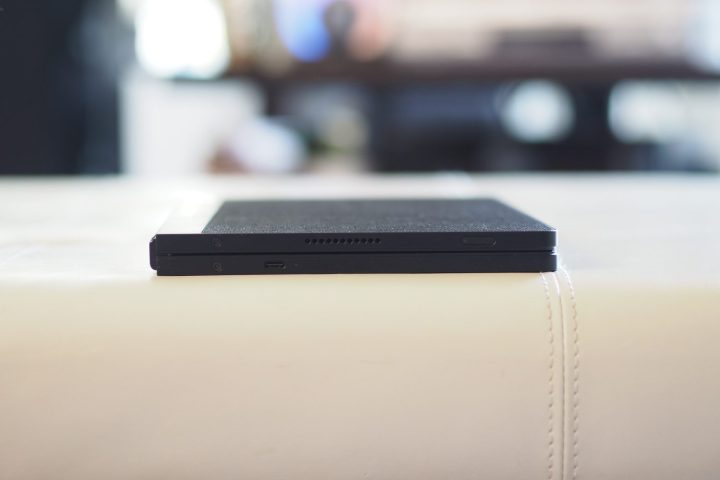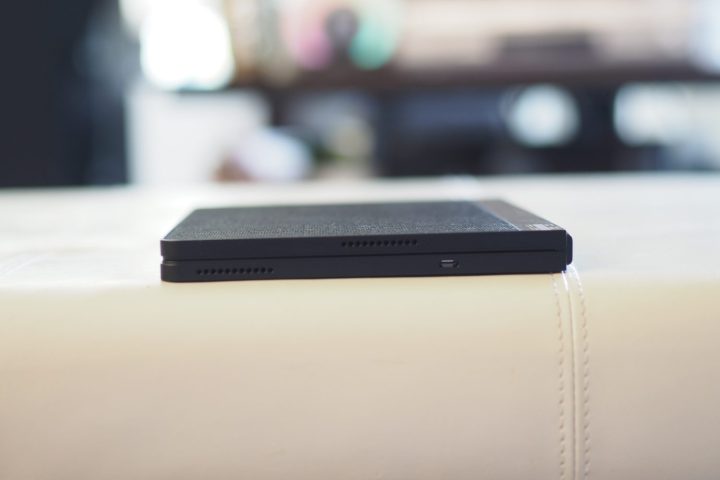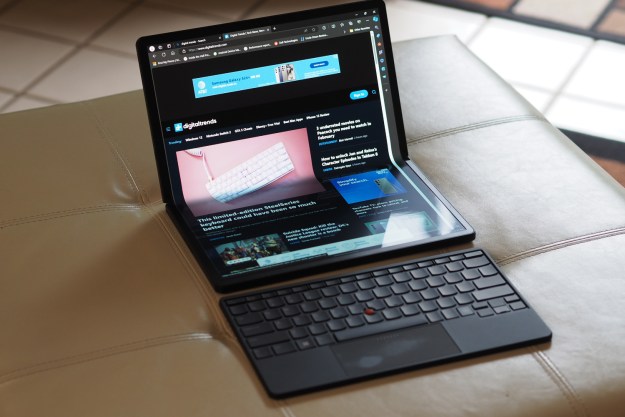
“The Lenovo ThinkPad X1 Fold suffers from a few fatal flaws.”
- Performance beats other foldables
- Thinner when folded
- Excellent haptic touchpad
- Bright OLED display
- Decent webcam
- Keyboard is cramped
- Stand is unreliable
- Inferior OLED colors
- Inconsistent battery life
Lenovo broke ground on foldable PCs with the original ThinkPad X1 Fold, a device with a 13.3-inch OLED display that folded down the middle. It could be used as a tablet, a clamshell with the external keyboard attached below the fold, and a “desktop” with the included stand. The device was a novelty, though, held back by poor performance and a cramped keyboard and touchpad.
The company’s second attempt is the ThinkPad X1 Fold, an entirely new product that retains the name and serves as Lenovo’s current foldable laptop. It increases the display size to 16.3 inches, which makes for a larger 2-in-1 that’s more useful as a clamshell but more cumbersome as a tablet. I found it an interesting but flawed take on the foldable PC that has much stiffer competition this time around.
Specs and configurations
| ThinkPad X1 Fold | |
| Dimensions | 13.61 inches x 10.87 inches x 0.34 inches (unfolded) 10.87 inches x 6.94 inches x 0.69 inches (folded) |
| Weight | 4.16 pounds (with keyboard/stand) 2.78 pounds (without keyboard/stand) |
| Processor | Intel Core i5-1230U Intel Core i5-1240U vPro Intel Core i7-1250U Intel Core i7-1260U vPro |
| Graphics | Intel Iris Xe |
| RAM | 8GB 16GB 32GB |
| Display | 16.3-inch 4:3 2.5K+ (2,560 x 2024) OLED |
| Storage | 256GB SSD 512GB SSD 1TB SSD |
| Touch | Yes |
| Ports | 1 x USB-C 3.2 Gen 2 2 x USB-C with Thunderbolt 4 Optional: NanoSIM slot |
| Wireless | Wi-Fi 6E and Bluetooth 5.1 Optional WWAN |
| Webcam | 5MP with infrared camera for Windows 11 facial recognition |
| Operating system | Windows 11 |
| Battery | 48 watt-hours 64 watt-hours (48Wh + 16Wh second battery) |
| Price |
$2,499+ |
Lenovo offers a wider range of configurations than its primary competitors, with a starting price of $2,499 for a Core i5-1230U, 8GB of RAM, a 256GB SSD, and without an active pen, keyboard, or stand. It’s unusual to omit a pen on a device like this, and adding one in is a $50 option. The keyboard and stand are a $300 option.
Fully configured, the ThinkPad X1 Fold costs $4,211, with a Core i7-1260U vPro, 32GB of
The laptop is far less functional without the keyboard, stand, and pen, so plan on spending the extra $350. The Asus Zenbook Fold 17 costs $3,500 in its sole configuration of the same CPU with 16GB of
Design
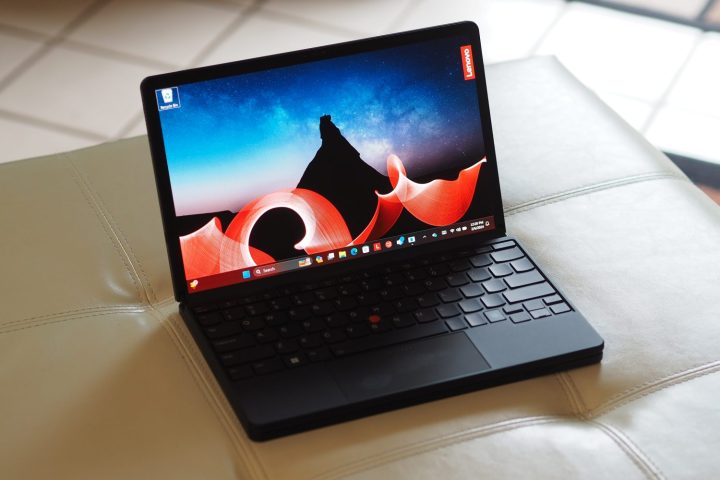
The two other foldable laptops we’ve reviewed, the Asus Zenbook Fold 17 and the HP Spectre Foldable PC, are similar in design and built around roughly 17-inch foldable OLED panels. That makes the ThinkPad X1 Fold with its 16.3-inch display slightly smaller, both when folded and unfolded. I noticed the biggest difference when the ThinkPad X1 Fold was closed, making for a more compact folio-like device to tote around.
The Lenovo is also heavier when the keyboard and stand are included, while the tablet is around the same weight. That gives it a denser feel.
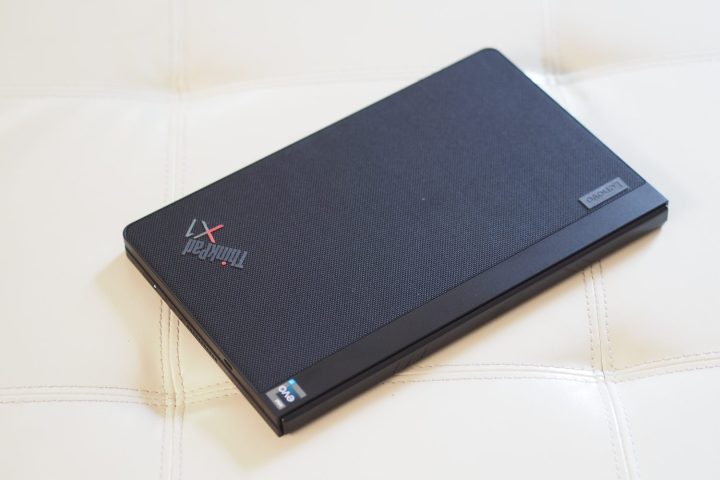
One significant design difference is that the ThinkPad X1 Fold has a more aggressive folded hinge design, with the folded halves lying flat against each other rather than sporting a gap, as with the other machines. The result is that the Lenovo is thinner when folded, at 0.69 inches versus the HP’s 0.84 inches.
There’s a catch, though — unlike the HP’s, the ThinkPad X1 Fold’s keyboard can’t be stored inside. The ThinkPad’s stand is also a separate component, whereas the HP and Asus stands are built into the tablet portion. The result is that with the ThinkPad X1 Fold, the keyboard and stand must be carried separately or attached magnetically to the bottom of the folded display — a thicker and arguably less convenient package.
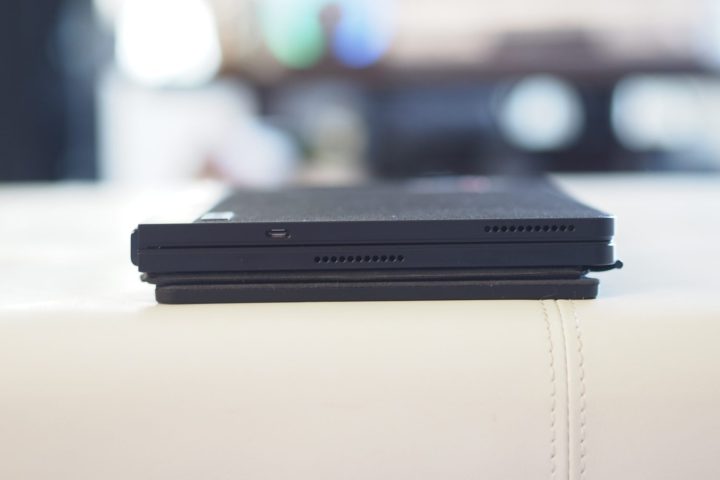
The ThinkPad X1 Fold is just 0.34 inches thin as a tablet, which is thinner than the Asus Zenbook Fold 17’s 0.61 inches and around the same as the HP Spectre Foldable PC’s 0.33 inches. The Lenovo is more comfortable as a tablet, given its smaller dimensions, but that’s not saying a lot. A 16.3-inch tablet is quite large to use in hand and is best when laid out on a surface.
That makes the active pen easier to use for inking, and the ThinkPad X1 Fold is no more comfortable than the HP or Asus in tablet mode. Lenovo highlights using the ThinkPad X1 Fold as a large reading device, with the display partly folded, but I found that format cumbersome. The ThinkPad’s hinge required more force to open than I remember needing with the HP, and the HP felt more balanced on each side of the fold.
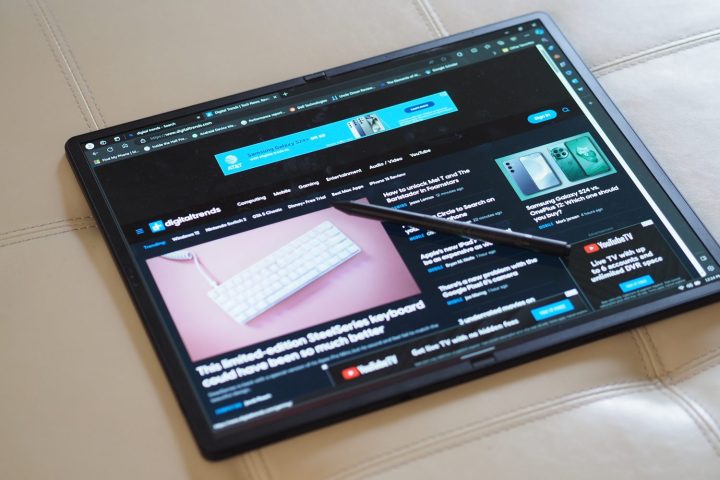
In clamshell mode, with the keyboard lying on the bottom half of the fold, the ThinkPad X1 Fold wasn’t as comfortable to use. The keyboard layout is more cramped, although the keycaps are large and feature the ThinkPad’s iconic sculpted design with the usual TrackPoint nubbin for those who like to use it. However, using the ThinkPad X1 Fold as a clamshell without the physical keyboard is made more difficult by the lack of a software keyboard that covers the entire bottom surface as well as having no software touchpad. The Spectre Foldable PC offers both.
The keyboard switches are light and snappy, which is great, but I preferred typing on the HP Spectre Foldable PC’s keyboard a lot more with its more spacious layout. The Lenovo’s clamshell display is also smaller, around 12 inches. Some screen is lost to the fold, which in clamshell mode forms a curve between the top of the display and the keyboard.
At the same time, Lenovo built a haptic touchpad into the keyboard, and while it’s smaller, it benefits from enabling clicks over its entire glass surface. The haptic mechanism is fast and offers natural-feeling clicks, and I liked it quite a bit better than HP’s mechanical touchpad. My only problem was that the keyboard goes to sleep after a few minutes and you have to press a key to wake it up. I usually tap a laptop’s touchpad, and I had to break some muscle memory.
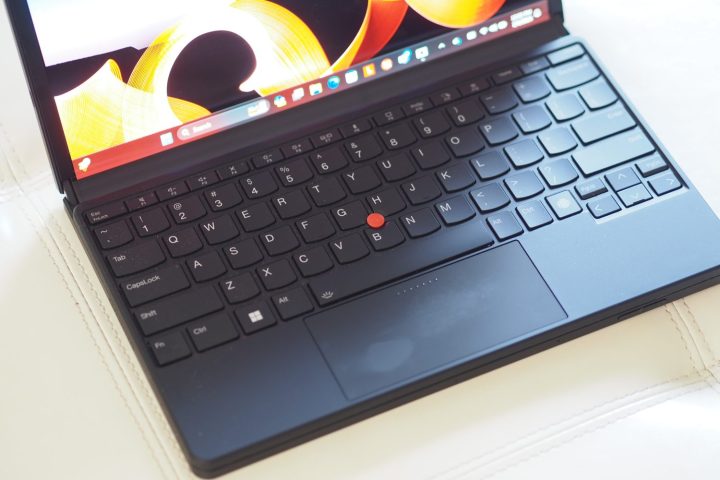
The final piece of the ergonomic puzzle is desktop mode, with the tablet portion propped up using the stand and the keyboard sitting in front. As mentioned above, the ThinkPad X1 Fold’s stand is a separate component rather than being built in. It magnetically adheres to one edge of the tablet in landscape and one edge in portrait, and I found it problematic. First, it’s another piece to carry around, and it adds bulk. Second, you have to choose your edges carefully.
If you accidentally try to prop the tablet up along the wrong edge, it won’t adhere, and you’ll test your reflexes trying to catch it from falling. I did that a couple of times and quickly learned my lesson. Unfortunately, it doesn’t work that well even when you’re attaching to the correct edge. Fortunately, I was lucky, and it never slid off my desktop. The HP and Asus feature built-in stands that avoid this menace.
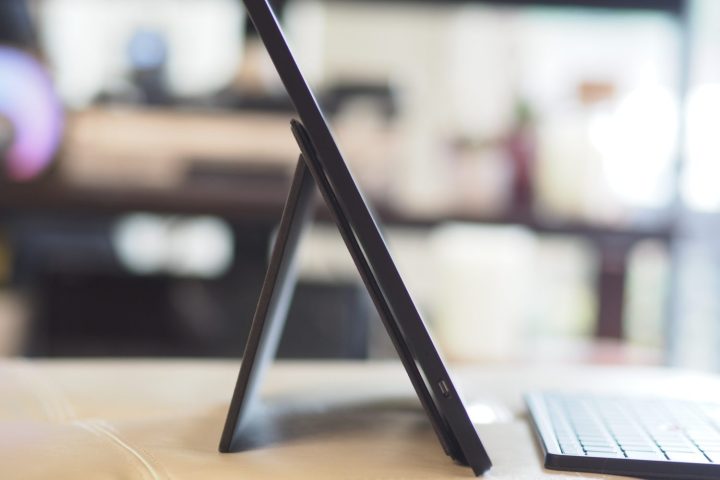
Physically, then, I found the ThinkPad X1 Fold less comfortable to use in two of its three modes, clamshell and desktop, and no better in tablet mode. None of the foldable PCs I’ve used were great to use as a clamshell without the physical keyboard, given the unsuitability of a software keyboard for typing anything other than short text.
The HP Spectre Foldable PC has a mode where the keyboard sits on the bottom two-thirds of the folded tablet and adds a second screen, and that’s missing on the Lenovo.
Ports
Tablets are thin devices and, as such, can’t fit in legacy ports like USB-A and HDMI. The ThinkPad X1 Fold is no different, and it offers just USB-C ports with and without Thunderbolt 4. Lenovo also skips a 3.5mm audio jack, which is always unfortunate, and there’s also no SD card reader. The Asus includes an audio jack, and neither has an SD card reader.
So, the Lenovo’s a mixed design. The tablet charges via USB-C, as does the keyboard. The pen that was included in my review configuration uses batteries. On the HP Spectre Foldable PC, the keyboard and pen charge magnetically when attached to the tablet.
The ThinkPad X1 Fold has Wi-Fi 6E and Bluetooth 5.1, which is typical, while it adds optional WWAN that the other two machines lack.
The ThinkPad X1 Fold’s camera matches the HP’s 5MP resolution, offering a quality image for videoconferencing. It’s along a short edge, though, making the angle weird in landscape mode. It has a built-in infrared camera for Windows 11 Hello that works quickly and reliably. The webcam was best in clamshell mode.
Display
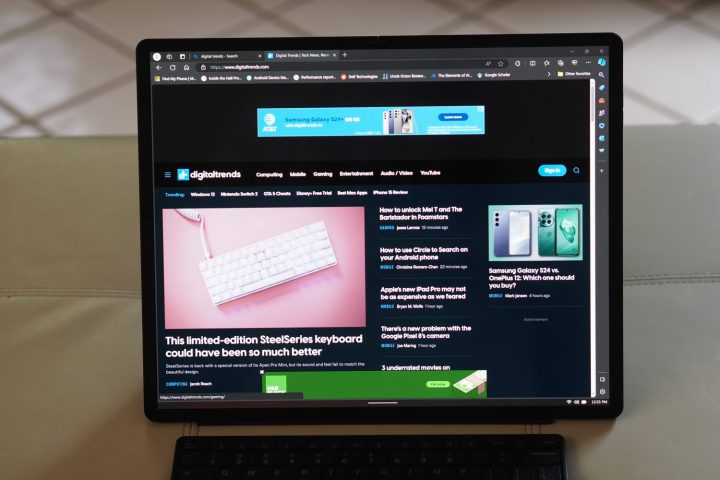
The ThinkPad X1 Fold uses a 16.3-inch OLED panel with an almost square 4:3 aspect ratio and a 2560 x 2024 resolution. That’s sharper than both the Asus and HP foldable PCs and just sharp enough to avoid obvious pixels in text. The aspect ratio makes for a more comfortable tablet while making the clamshell display quite small.
According to my colorimeter, the display was brighter than most OLED screens at 438 nits, and it had the technology’s usual perfect blacks and inky contrast. Its colors weren’t as wide as most, at just 93% of AdobeRGB, where most OLED displays are closer to 100%, and its color accuracy was just okay at a DeltaE of 1.52 (most are under 1.0).
Overall, the ThinkPad X1 Fold was an excellent visual experience for productivity and media consumption. The display supports Dolby Vision high dynamic range (HDR) video, but I was unusually unimpressed when running Netflix
Audio is provided by two speakers on the edges of the tablet. In clamshell mode, they point to the sides, while in landscape desktop mode, one speaker is firing up, and the other is firing down and muffled by the stand. Overall sound quality was good but not great, with clear mids and highs but zero bass.
Performance and battery life

The ThinkPad X1 Fold uses Intel 12th-gen low-power CPUs, with options for vPro technology that can plugged into enterprise security and management systems. I tested with the Core i7-1250U, the same 10-core (two Performance and eight Efficient), 12-thread CPUs used in the HP Spectre Foldable PC and the Asus Zenbook Fold 17. These are 9-watt chips that meet the efficiency requirements and aren’t currently available in Intel’s 13th- and 14th-gen chips.
Even so, the ThinkPad provided faster performance than the other two machines. Whether this is the result of Lenovo’s better cooling (each foldable machine is fanless) or more aggressive tuning, I don’t know. Not that while the Lenovo is faster, that doesn’t make it a fast machine. It’s competitive with other similarly configured
The ThinkPad X1 Fold is fast enough for general productivity use and media consumption. These are the best uses for the machine, so the performance is sufficient — but just barely. And don’t even think about gaming on this laptop.
| Geekbench 5 (single/multi) |
Handbrake (seconds) |
Cinebench R23 (single/multi) |
PCMark 10 Complete |
|
| Lenovo ThinkPad X1 Fold (Core i7-1250U) |
Bal: 1,672 / 6,880 Perf: 1,672 / 7,440 |
Bal: 160 Perf: 139 |
Bal: 1,489 / 5,246 Perf: 1,541 / 6,356 |
4,841 |
| HP Spectre Foldable PC (Core i7-1250U) |
Bal: 1,684 / 4,569 Perf: 1,684 / 6025 |
Bal: 269 Perf: 179 |
Bal: 1,380 / 3,911 Perf: 1,507 / 4,785 |
4,556 |
| Asus Zenbook Fold 17 (Core i7-1250) |
Bal: 1,584 / 5,821 Perf: N/A |
Bal: 219 Perf: N/A |
Bal: 1,172 / 3,319 Perf: N/A |
N/A |
| Lenovo Yoga Book 9i (Core i7-1355U) |
Bal: 1,797 / 6,926 Perf: 1,804 / 7,815 |
Bal: 181 Perf: 118 |
Bal: 1,681 / 6,303 Perf: 1,758 / 7,576 |
5,514 |
| Microsoft Surface Laptop Go 3 (Core i5-1235U) |
Bal: 1,179 / 5,652 Perf: 1,524 / 6,226 |
Bal: 194 Perf: 214 |
Bal: 1,118 / 5,170 Perf: 1,534 / 4894 |
4,227 |
| Apple MacBook Air M1 (M1) |
Bal: 1.727 / 7,585 Perf: N/A |
Bal: 156 Perf: N/A |
Bal: 1,479 / 6,680 Perf: N/A |
N/A |
Two battery capacities are available for the ThinkPad X1 Fold: a single 48-watt-hour battery and 64 total watt-hours with an additional 16-watt-hour battery. My review unit was configured with the full capacity, and with a 16.3-inch OLED display, I wasn’t expecting miracles.
As it turned out, battery life was distinctly mixed. In clamshell mode with the keyboard attached and, presumably, one-half of the OLED display turned off, I saw just four hours in our web browsing test and 11.5 hours in our video looping test. With the display unfolded and in desktop mode, I saw seven hours of web browsing and 10.25 hours of video looping. The HP Spectre Foldable PC demonstrated some of the same battery performance, with a longer battery life with the full display. It lasted greater than 8.5 hours of web browsing, though, so its battery life was significantly better.
I can’t account for the discrepancy between clamshell and desktop modes. But I can say that you’re unlikely to get to a full day of work without plugging in.
A disappointing option
As I used the ThinkPad X1 Fold, I was constantly disappointed in one aspect or another. The stand wasn’t reliable, which is a very bad thing when it’s meant to prop up a tablet that starts at $2,499. Lenovo’s Yoga Book 9i has a much more complicated origami stand that holds that dual-display 3-in-1 firmly in place. So, Lenovo knows how to get it right and just didn’t. I also found the clamshell mode too small and, without its keyboard, too hard to use.
Performance was better than the other two foldable PCs we’ve used, but battery life was worse. The Asus Zenbook Fold 17 is less expensive with a reasonable configuration. The ThinkPad X1 Foldable isn’t the best option among today’s leading foldable PCs.
